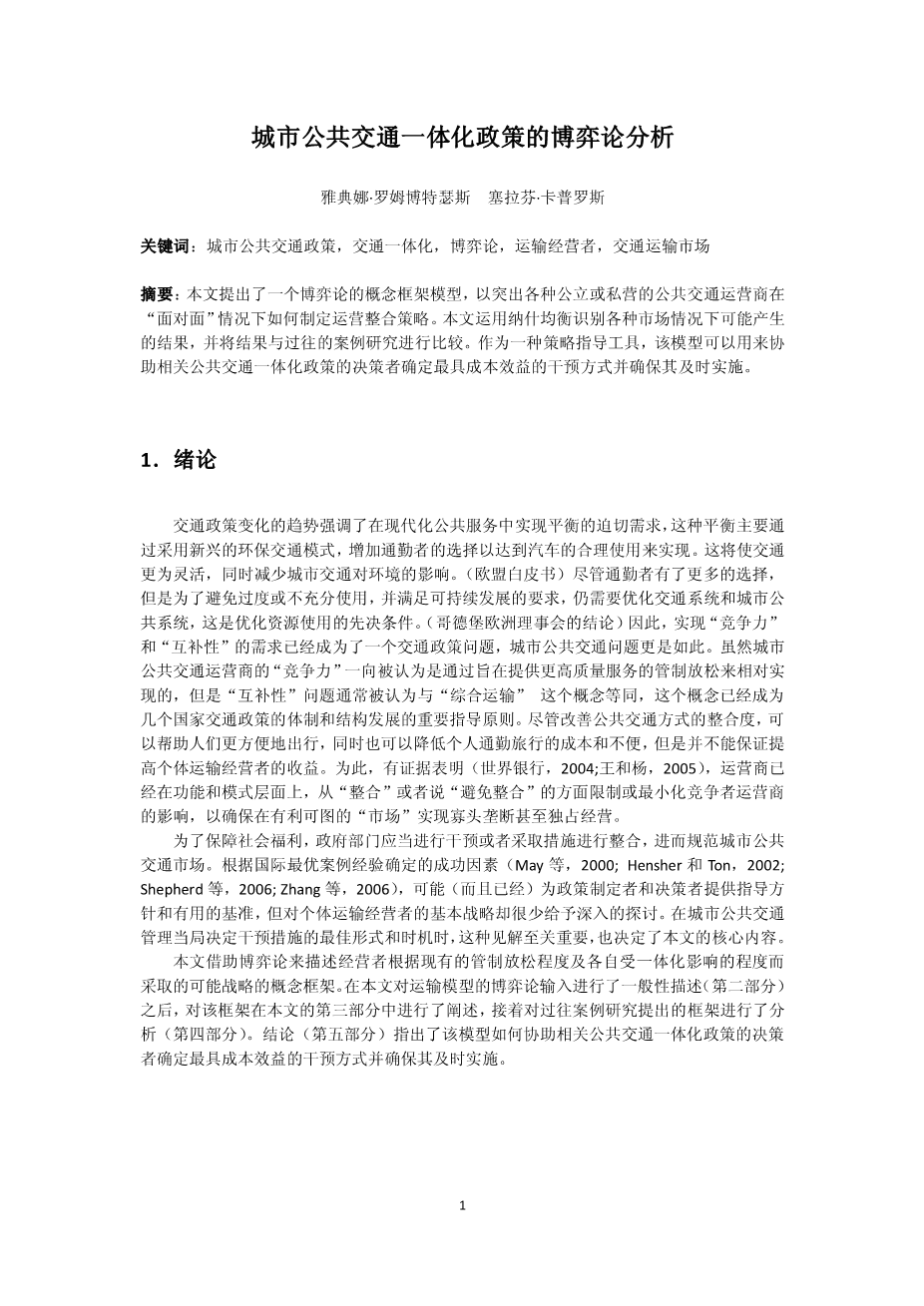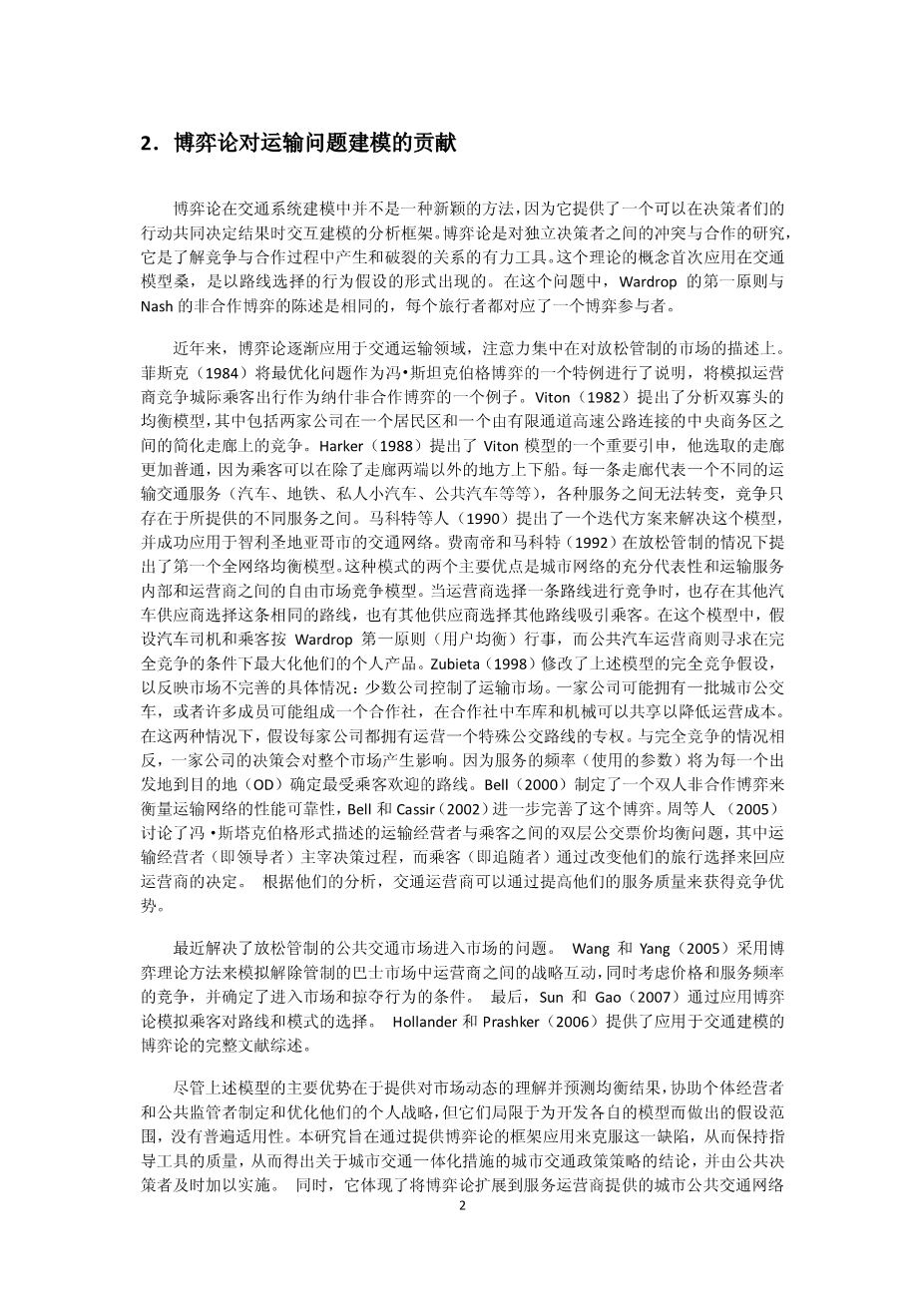A game theory approach to urban public transport integration policy
Athena Roumboutsos , Seraphim Kapros
Keywords: Urban public transport policy ,Transport integration ,Game theory ,Transport operators ,Transport market
Abstract: A game theoretic conceptual framework model is presented to highlight strategies undertaken by individual public transport operators, public or private, vis-a` -vis operational integration strategies. The Nash equilibrium is used to identify possible outcomes in various market situations. These are compared with reported case studies. The model, as a strategy-guiding tool, may be used to assist transport policy decision-makers concerned with public transport integration in identifying the most cost-effective form of intervention and its timely implementation.
- Introduction
Transport policy trends emphasise the need to strike a balance between the modernisation of public services, with the introduction of new eco-friendly transport modes, and the rational use of the car, through the introduction of an increased number of options to the commuter, which would provide flexibility while reducing the environmental impact of urban transport (EU White Paper). Notwithstanding the advantages to the commuter of an increased number of options, the need to optimise transport systems and, hence urban public systems, is a prerequisite to the optimal use of resources, in order to avoid over- or underutilisation and meet the demands of sustainable development (conclusions of the Gothenburg European Council). Therefore, the need to achieve ‘‘competitiveness’’ and ‘‘complementarity’’ has become an issue in transport policy and more so in urban public transport. While ‘‘competitiveness’’ of urban public transport operators is considered to be induced through relative forms of deregulation aiming at the provision of improved quality services, the issue of ‘‘complementarity’’ is often seen to coincide with the concept of ‘‘integrated transport’’; a concept that has become an important guiding principle for transport policies’ institutional and structural development in several countries. However, whilst improved integration between the public transport modes helps people to move around more easily and reduces the costs and inconveniences of travel for the individual commuter, it does not guarantee improved pay-offs to the individual transport operator. To this end, there is evidence (World Bank, 2004; Wang and Yang, 2005) that the aspect of ‘‘integration’’—or rather ‘‘avoidance of integration’’—on a functional and modal level has been used by operators to restrict or minimise the effect of competitor operators in order to secure profitable ‘‘market’’ oligopolies or even monopolies.
In order to secure social welfare, regulating public authorities are required to intervene imposing or investing in measures by which integration will be achieved and, subsequently, regulating an otherwise deregulated urban public transport market. The identification of success factors based on best practices stemming from international experience (May et al., 2000; Hensher and Ton, 2002; Shepherd et al., 2006; Zhang et al., 2006) may (and has) provided guidelines and useful benchmarks for policy and decision-makers but has attributed little insight as to the underlining strategies of individual transport operators. This insight is considered crucial in deciding the optimum form and timing of an intervention induced by the responsible urban public transport authority and formulates the core of the present paper, which resorts to game theory to describe a conceptual framework of possible strategies adopted by operators depending on the existing level of deregulation and their respective impact on the notion of integration. The framework is formulated in the Section 3 of this paper proceeded by a general description of game theoretic input to transport modelling (Section 2) and followed by the analysis of the framework supported by reported case studies (Section 4). Conclusions (Section 5) indicate the use of the formulated game theoretic framework in assisting transport policy development and decision-makers to identify the most cost-effective form of intervention and its timely implementation.
- Game theory contribution to transport modeling
Game theory is not a novel approach in transport systems modelling, as it provides a framework for modelling interactions between groups of decision-makers when actions jointly determine the outcome. Game theory is the study of conflict and cooperation among independent decision-makers. It is a powerful tool in understanding the relationships that are made and broken in the course of competition and cooperation. Concepts from this theory first appeared in transportation models in the form of a behavioural hypothesis for route choice, Wardrop’s first principle, being identical to the statement characterising a Nash noncooperative game, with each traveller corresponding to a player.
Recently, game theory has been gradually applied in the traffic and transportation fields. Attention has been focused on the description of deregulated markets. Fisk (1984) illustrated the optimisation problem as a special case of the von Stackelberg game3 and modelled operators competing for intercity passenger travel as an example of the Nash non-cooperative game. Viton (1982) developed equilibrium models for the analysis of a duopoly, which consisted of two firms competing on a simplified corridor between a residential area and a central business district connected by a limited-access highway. An important extension of Viton’s model was proposed by Harker (1988). His representation of corridors is more general in that it allows passengers to embark/disembark at points other than the extremities of the corridor. Each corridor represents a deferent transit service (automobile, sub-way, private mini
剩余内容已隐藏,支付完成后下载完整资料


英语译文共 10 页,剩余内容已隐藏,支付完成后下载完整资料
资料编号:[463707],资料为PDF文档或Word文档,PDF文档可免费转换为Word


